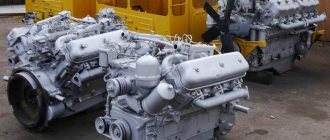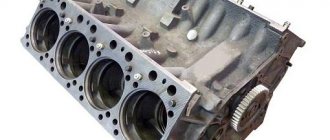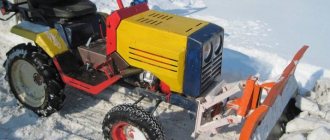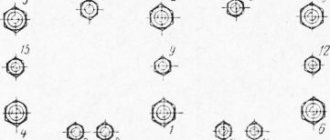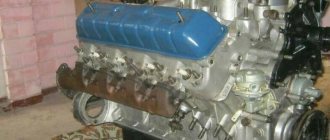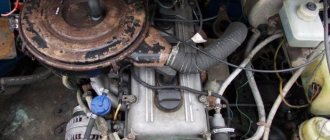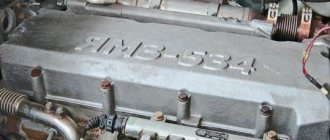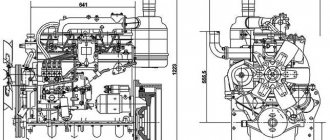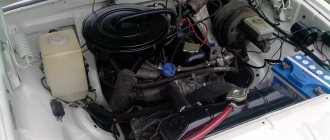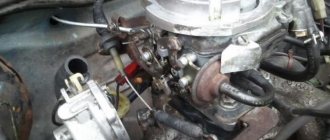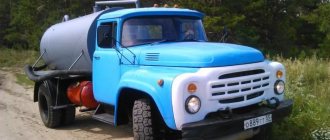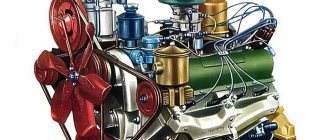Category: ENGINE
- The history of the 402 engine
- Device - 402 motors
- Technical characteristics of the 402 engine
- Engine types
- The main problems of the 402 engine
- Valve adjustment - 402 engine
- Required Tools
- Procedure for adjusting valves 402 engine
If each engine were awarded a title, then the ZMZ 402 engine would become “legendary”. The traction unit began to be produced at the Zavolzhsky enterprise, at a time when the growth of industrial development was gaining momentum. The use of the unit began in 1980. The product, after a “light” modification of the ZMZ-24D engine (produced since 1968), received a new marking, and at the same time replenished the number of admirers. At that time, not every technique had the characteristics and resource inherent to the product, so the demand was natural.
The index “402 engine” denotes a line of units, which, after fine-tuning and improvement, amounts to several copies. The unifying factor is the use of gasoline and four cameras lined up in a row. The traction family was used on GAZ products (Volga, Gazelle), Riga Latvia buses, and cars from the Ulyanovsk plant.
ZMZ-402:
History of ZMZ 402
The history of the creation of ZMZ 402 begins in the distant 50s. It was then that the design of the motor was developed, which became the basis for the creation of the 402 engine. Its founder, the legendary Soviet designer Harry Voldemarovich Evart.
The talented designer, the Soviet government, was tasked with creating a new engine for the Volga. As a result of long work, a four-stroke engine with a volume of 2.4 liters was created, with wet insert liners and a lower camshaft position. The motor with these parameters was called ZMZ 24D, it had other names and modifications, GAZ 24, ZMZ 24. Serial production of this power unit began in 1968. The engine was constantly improved and refined, and in 1981, its improved version was released, labeled ZMZ 402. The production of the new engine successfully continued for more than 35 years, it became the most widespread in the entire history of engine building. The last engine of the 402 model was assembled in 2017. By that time, more than 6 million four hundred second engines had been produced. It was replaced by a more powerful and modern power unit ZMZ 406.
Types of manufactured modifications of ZMZ 402
The ZMZ 402 engine is the general name of the model range of engines produced by the Zavolzhsky Motor Plant.
Their family includes five very similar engines, with slight differences and their purpose:
- The most common and main motor is considered 402.10 . Its purpose is to equip Volga passenger cars. It is designed to use AI 92 gasoline and has a compression of 8.2:1.
- The second place in importance is occupied by the engine with SS 6.7 running on AI 76. Its marking is ZMZ 4021.10 . Used on Volga cars.
- ZMZ 4022.10 engine had the biggest difference from the main model. Its design at that time was too complex: a different camshaft was used, the carburetor, the exhaust and intake had a different design. The most significant difference is the use of prechamber-torch ignition. All these puzzles were supposed to solve the problem of harmful substances in exhaust gases and significantly reduce fuel consumption. However, the desired results in terms of economy and ecology were not obtained. Therefore, such a motor was not widely used, and in 1992 the production of prechamber engines ceased completely.
- The ZMZ 4026.10 power unit runs on 92 gasoline, it is an analogue of the 402.10 model. The main difference is its purpose. This modification was used on Gazelles.
- 5. The fifth modification, ZMZ 4025.10 , was also intended for Gazelles. By and large, this is the same 4021.10 running on AI 76. The difference between them is only in application.
List of car models in which it was installed
The ZMZ 402 motor was created for the Gorky and Ulyanovsk Automobile Plants, the Riga Bus Factory, and therefore was used to complete cars:
- GAZ-24-10 Volga – 1985 – 1993;
- GAZ-3102 Volga – 1981 – 2006, only pre-chamber modifications of the internal combustion engine;
- GAZ-31029 Volga – 1992 – 1997;
- GAZ-3110 Volga – 1997 – 2005;
- GAZ-31105 Volga – 2002 – 2006;
- GAZ-3302 Gazelle – 1994 – 2003;
- GAZ-33023 Gazelle-Farmer – 1995 – 2003;
- GAZ-2705 Gazelle cargo-passenger – 1995 – 2003;
- GAZ-3221 Gazelle minibus – 1996 – 2003;
- GAZ-32213 Gazelle luxury minibus – 1996 – 2003;
- GAZ-322132 Gazelle minibus (sliding door) – 1996 – 2003;
- GAZ-32214 Gazelle “ambulance” – 1996 – 2003;
- RAF-M1 Roxana and RAF-M2 Stills - released in a single copy, did not go into series;
- RAF-33111 – two-seater flatbed truck 1 ton;
- RAF-22038 – minibus, small production volumes;
- RAF-22039 is a large minibus.
The characteristics of the engine made it possible to use it in Gazelle special equipment, the line of which was produced by the Mytishchi Kupava plant. In Ukraine, the Chasovoyarsky repair plant assembled Ruta buses with these engines, the Chernigov plant - Bogdan-A049 and TUR-A049, the Boryspil Automobile Plant - BAZ-2215 Dolphin.
BAZ Dolphin
Social (resuscitation and hearse) and school buses with power drive ZMZ 404 were assembled by the Semenovsky Automobile Repair Plant from 1995 to 2006. Some parts were used in UAZ engines as components.
Technical data ZMZ 402
Four-stroke petrol engine with in-line arrangement of four cylinders. Produced at ZMZ from 1981 to 2022.
- The exact engine volume is 2445 cubic centimeters.
- The BC is made of especially durable aluminum, the sleeves are wet, steel liners are in direct contact with the coolant.
- Power supply system 402 motor carburetor.
- The piston stroke is equal to the cylinder diameter, 92 mm. People call such engines square. They are highly reliable.
- The cylinders work in a certain order: 1, 2, 4, 3.
- The compression ratio depends on the modification and the type of gasoline used; for engines using AI 92, the compression ratio is 8.2:1, engines with AI 76 have a compression ratio of 6.7:1.
- The power of the ZMZ 402 at 4500 rpm is 100 and 90 hp, depending on the engine model.
- Torque at 2500 rpm, 182 and 172 Nm.
- The weight of the ZMZ 402 181.184 kilogram.
Fuel consumption
Average fuel consumption is about 13 liters per 100 km, mileage.
Oil - what is the consumption, when to change, what to fill
The permissible consumption of motor lubricant is 0.1 liters per 1000 km. Types of oil used: 15W40, 5W40, 10W40, 10W30. The oil volume in the engine is 6 liters, when replacing, take 5.8 liters. According to the manufacturer, the period for replacing engine lubricant is 10,000 km. To increase the life of the internal combustion engine, it is better to change the oil after 5 thousand kilometers.
The normal operating temperature of the internal combustion engine is 90C.
Engine life
The service life of ZMZ 402 according to the manufacturer is 200 thousand km. With proper maintenance and careful operation, this engine can travel more than 300 thousand kilometers.
Reviews from owners of "3M3-402"
The advantages of the 3M3-402 engine, which almost all Volga owners with these engines talk about, are: simplicity, exceptional survivability and maintainability. Buying spare parts for this motor is not a problem, and they are inexpensive.
The 3M3-402 engine, compared to other engines, can withstand overheating, operation under increased load, and similar difficult situations quite easily. The simplicity of its design allows the owner to carry out maintenance and repair of the motor in a regular garage workshop, without the involvement of special equipment and highly qualified personnel.
Typical reviews from Volga and GAZelle owners with 3M3-402:
“The 3M3-402 engine was on my Volga-31029. During the entire period of operation while I had this car (this is, in total, more than three years), this motor let me down only once: the rod broke - one of the valves stopped opening, and the rest of the time the 402nd motor worked like a clock "
“The 3M3-402 engine started on my Volga from the starter in any frost, even when it was minus 35-40; without preheating. Apparently because he was configured correctly. It’s generally easy to set up and adjust.”
“The 402 3M3 is a really powerful engine and pulls great under heavy load. “I’ve had situations more than once when I, out of necessity, overloaded the car 2 times more than the permissible limit, and the car, although the bottom caught bumps on the road, drove calmly and even accelerated to 80 kilometers per hour.”
“In terms of reliability and stability of operation, everything is great. I've been driving it for 4 years now and have never had any breakdowns. Among the disadvantages, one can note considerable fuel consumption. In fact, all Volgov engines eat a lot, but they also have an impressive power reserve. The Volga is a heavy car. Therefore, in order to carry such weight, you need to have a powerful, energy-charged engine, which is what the 3M3 402 is. It is extremely simple and reliable if you follow the rules of its operation and maintenance.”
“3M3-402” is an extremely reliable and durable hard-working engine; if you take care of it, it will definitely respond well. Nowadays we are all spoiled by foreign cars; cars with “3M3-402” are, of course, a thing of the past. But those who cannot afford the purchase of a modern foreign car should trust cars with such an engine. He won’t shell out much money.”
There are many examples of tuning and additional development of the engine of this model. Right down to equipping it with an injector - a full-fledged electronic injection system. Some owners completely reconstruct the ignition system: they turn it into a 2-circuit system (as in the more modern 3M3-402 engine), while installing two switches, 2 ignition coils, and the entire distribution sensor is being worked out.
To boost the 3M3-402 engine without losing its service life, racing enthusiasts increase the carburetor diffusers to 26/30mm, install a camshaft and a direct-flow exhaust of equal diameter along the entire length. Such tuning can be freely done with your own hands, and the engine output power is 120-130 horsepower.
To increase efficiency, the cylinder head is milled to a height of 93mm, to increase the compression ratio, which adds a few more “horses” to the engine. An even easier way to make a 3M3-402 is to install a compressor (SC-14 or Eaton M90) that will blow into the carburetor. But, of course, the costs, both financial and technological, associated with such types of development are not entirely small.
Description of the features of the ZMZ 402 internal combustion engine
ZMZ 402 is a legend of the domestic engine industry. Its roots go back to the first engine for the Volga - Gas 21. The power unit consists of an aluminum BC with wet liners, this is when the cooling jacket runs along the walls of the steel liner. The gas distribution mechanism, the same as on the GAZ 21, has a lower camshaft placement.
The valves are driven by rocker arms that push rods, receiving impulse from the camshaft. The similarity with the prototype is undoubtedly great, but changes and improvements took place on the 402 engine.
The exhaust manifold has undergone changes. The camshaft lift has increased by 0.5 mm. Previously it was 9 mm, after modification it became 9.5 mm. The cylinder head studs and the head itself have changed. The oil pump was installed with a different design, and there were other small changes. It was in this form that the 402 engine survived into the 21st century, winning a large army of connoisseurs for its simplicity and maintainability.
Valve adjustment - 402 engine
The design of the power plant is outdated: the camshaft located at the bottom, rods, and the quality of the parts are the cause of vibrations and uneven loads on the gas distribution mechanism. For this reason, after a run of 5000-15000 km, the required clearance in the valve mechanism is set. It is worth noting that the mileage range is related to the manner in which the engine is operated. Careful use, without sudden starts, allows you to adjust the valves after 15,000 km, moderate loads - 10,000 km, operation on gas - 5,000 km. This approach will reduce the risk of valve damage and engine failure.
Set of probes:
Design of BC ZMZ 402
The cylinder block of this power unit was cast from a durable aluminum alloy. The casting of the product was carried out using two technologies. To increase the tightness and better fill the micropores, the BC was impregnated and thermally treated with a special resin. This technology was called chill casting. Also, the high pressure casting method was used. The method of manufacturing the BC depended on the modification of the engine and the year of manufacture. So BC ZMZ 4022.10 was always cast in a chill mold. BC 4021.10 was manufactured only under high pressure. And the most common engine, 402.10, was manufactured in different ways depending on the year of manufacture.
Depending on the manufacture of the BC, the sleeves are fixed in the block differently. So, for a block made by the chill mold method, the sleeves have an upper bolt and are fixed at the top of the BC. The cylinder block, manufactured under high pressure, has an open jacket on top and the liners are fixed in it along the bottom of the BC.
The upper contour of the cylinder head has ten bosses intended for fastening the cylinder head. At the bottom of the block there are four compartments separated by partitions. These partitions, in turn, serve as supports for the main bearings of the ZMZ crankshaft. The bearing caps are made of ductile cast iron and are secured using two studs with a diameter of 12 mm.
The cover for the first bearing is processed from the ends to install washers for the thrust bearing. The inner walls of all covers are processed together with the block. Therefore, when assembling, each one must be put in its place. The three middle covers are numbered. And it is impossible to confuse the first with the fifth, since the first is also processed from the ends.
The gear cover is installed on the end of the BC, located in front, through a foam gasket. The cover has a rubber cuff, which is necessary to seal the crankshaft toe.
A clutch housing made of aluminum is bolted to the rear end of the BC. The KS requires precise adjustment using locating pins. Accuracy of installation is necessary for flawless operation of the manual transmission.
The clutch housing, its rear end and the hole for the manual transmission shaft are processed together with the BC to maintain alignment. Therefore, you only need to install the original clutch housing. It will not be possible to install it from another engine; the alignment of the input and crankshaft will be disrupted.
Detailed disassembly of the 402 engine
The internal combustion engine cylinders are made of especially durable cast iron; their design is represented by wet insert liners. The jacket with coolant in them runs directly along the outer wall of the cylinders. The fixation of the sleeves depends on the method of manufacturing the BC; this is specifically discussed at the beginning of the chapter. The liner is sealed at the bottom with a soft copper gasket, and at the top with a cylinder head gasket.
For a reliable seal, the top of the sleeve must protrude above the cylinder head by no less than 0.02 mm and no more than 0.1 mm. The difference in height between sleeves on the same engine must be less than 0.055 mm. This accuracy is achieved by sorting and selecting sleeves and blocks according to acceptable distances.
Design of the ZMZ 402 cylinder head
The cylinder head of this engine is common to four cylinders. It is cast from a particularly durable aluminum alloy under high pressure. The valve seats are plug-in, made of especially durable cast iron. The material used for making valve bushings is cermet.
When assembling the cylinder head, a unique technology is used: the bushings and valve seats are cooled, and the head is heated. The metal of the head is additionally pressed around the valve seats using a mandrel. Seats and bushings undergo fine processing together with the BC head.
The ZMZ 402 cylinder head is attached to the BC using ten studs made of steel, their diameter is 12 mm. For strengthening, special steel washers are installed under the nuts.
There is an asbestos gasket between the cylinder head and the cylinder head; it has a graphite coating and a frame made of metal reinforcement. The gasket windows intended for combustion chambers are edged with tin. The compressed height of the gasket is no more than 1.5 mm.
ICE theory: cylinder head ZMZ-402
Correctly installing the BC head on the block is helped by two pins secured in the BC. The heads of the BC 402 and 4021 engines differ in the size of the combustion chambers. The higher compression ratio of the 402 motor is achieved thanks to increased milling of the lower part of the head. Thanks to this, the height of the engine head 402.10 is less than the height of the engine 4021.10, 94.4 mm, and 98 mm, respectively. The difference in height is 3.6 mm. Due to this, an SS of 8.2: 1 is obtained, allowing the 402 engine to run on AI 92 gasoline. Instead of a 4021 engine with a CV ratio of 6.7:1 and running on 76 gasoline.
Procedure for adjusting valves 402 engine
- Remove the hoses connected to the valve cover and ignition;
- Disconnect the throttle drive attached to the engine valve plug;
- Remove the valve plug; to do this, remove the six clips; you may have to remove the air filter element;
- Remove the engine spark plugs;
- Place the chamber displacer “1” at the top dead center: connect the mark “3” on the pulley with the shoulder on the motor frame;
- Remove the distributor plug, make sure that the position of the running roller coincides with chamber contact one. Otherwise, rotate the shaft and repeat the procedure;
- Adjust the valves: “1246” then rotate the shaft so that the notches of the pulley and the frame coincide, adjust the valves “3578”;
- To adjust the valve, move the rotating pair, then, without applying much force, hit it with a hammer from the valve side;
- Holding the adjustment screw with a key at “11”, unscrew the nut;
- Check the gap and adjust if necessary. How many millimeters to set is related to the load on the engine; the standard adjustment is 0.4 mm;
- Hold the bolt with a wrench or screwdriver and secure the part with a nut. If the gap is the right size, adjust the next valve; if not, repeat the adjustment;
- Reassemble the spark plugs, cover, and conductors in the reverse order;
- Start the engine, make sure that every element of the mechanism is lubricated. Otherwise, release the rocker axis lock (chamber “4”);
- Turn off the engine, install the valve covers, fix the bolts, install the pipes;
- Start and warm up the engine, check that there is no knocking noise on the unit. Correct adjustment eliminates metallic ringing and clattering.
Timing belt design features
Low camshaft. It is installed at the bottom of the BC on five supports. A gear is installed on the camshaft to drive the ignition distributor, as well as the oil pump.
Timing diagram
The timing drive is carried out through a plastic gear, which meshes with a metal crankshaft gear. The cams of the shaft intended for gas distribution influence the pushers, which, using rods, drive the valves through rocker arms. The timing shaft is held against axial displacement by a steel flange located between the gear oxbow and the end wall of the camshaft journal.
Lubrication system ZMZ 402
The lubrication system of this internal combustion engine is carried out under pressure and, as on most engines, by splashing.
Under pressure, engine lubricant lubricates the crankshaft plain bearings, camshaft bearings, push rods, their upper tips and rocker arm bushings. Other components and parts are lubricated with sprayed engine oil.
The ZMZ 402 system consists of the following parts and mechanisms:
- oil pump;
- inlet pipe with coarse filter;
- editorial valve;
- oil filter;
- oil channels;
- oil sump;
- engine lubrication level indicator;
- sensor indicating oil pressure;
- sensor signaling emergency engine lubrication pressure;
- oil filler neck with plug.
Oil, through the oil receiver, is taken from the engine crankcase by a pump. It is then sent to the oil filter. Filtered motor lubricant is supplied under pressure through oil channels to the main bearings of the crankshaft and camshaft.
Lubrication system diagram
The rear camshaft support has an annular groove through which oil flows to the rocker arm axis, then to the rocker arm bushings and the upper tips of the pushrods.
The connecting rod journals of the crankshaft are lubricated with engine lubricant supplied under pressure through channels drilled from the crankshaft main journals.
The timing gears are lubricated with oil supplied through a special tube, the reverse end of which is pressed into the block to the oil channel. From the outlet end of the tube, a stream of oil sprays the timing gears. The gears driving the oil pump are lubricated by a stream of oil ejected from a channel in the BC, located near the fourth camshaft journal.
All other parts and assemblies receive lubrication from oil flowing from the clearances of the plain bearings and oil sprayed by the crankshaft and mechanical components of the engine.
Oil selection
The manufacturer recommends using motor oils that have the following indicators according to the SAE standard, which determines the fluidity (viscosity) of a lubricant:
- 5W-30;
- 10W-30;
- 5W-40;
- 10W-40;
- 5W-40.
It is advisable to fill the engine with mineral or semi-synthetic oil from Russian and foreign manufacturers. When using more liquid or synthetic ones, you may encounter leakage through the seals or gaskets.
Important: mineral oil should only be used in the summer. In winter, you need to fill in “semi-synthetic”, which thickens less in the cold.
Typical malfunctions of ZMZ 402
The ZMZ 402 engine is subject to many malfunctions and breakdowns:
Oil seal leak
The most painful place of the 402 internal combustion engine is the oil seal located behind the crankshaft. The rear oil seal is a packing consisting of graphite impregnated rope that is wrapped around the rear end of the crankshaft. Then the wound rope is pressed with a special washer. This design holds motor lubrication well at medium engine speeds. If the internal combustion engine is used at speeds of more than 2500 rpm, then the lubricant begins to seep out. The problem can be solved by replacing the stuffing box.
Troit motor
Overheat
The next most important problem is overheating of the 402 motor. The reason, like most modern engines:
- thermostat malfunction;
- coolant leak;
- clogged cooling radiator;
- failure of the radiator fan;
- water pump malfunction;
- water plug.
But overheating is not as dangerous as its consequences. The thing is that the body of the internal combustion engine 402 engine does not heat evenly. The middle of the BC heats up more than the rest of the motor. Over time, the washers become pressed into the engine. The nuts are loosening. If you do not tighten the head in time, the cylinder head gasket may burn out. Which can lead to coolant getting into the oil. If you do not take measures to eliminate the malfunction and change the oil in time, major repairs will not take long.
Vibrations
Motor vibrations are a common problem. The problem may be in the support cushions. If everything is in order with the airbags, the malfunction may be a problem of the ignition system, power system, or crankshaft imbalance.
Unstable idle
Problems with the internal combustion engine idling. This problem is common with 402 motors. This is due to the design of the aluminum intake manifold. Because of this, the combustible mixture enters the cylinders unevenly, which affects the idle speed of the internal combustion engine.
Valves knocking
Engine knocking occurs due to unadjusted valve clearances. Valve adjustment should be done without waiting for a knock in the engine, after 15 thousand km. The problem can be solved specifically by installing hydraulic compensators from the ZMZ 406 model. If the valves are not the cause of the knocking in the engine, then the crankshaft bearings may be knocking. This is much more dangerous, since such a knock is a sign of an imminent major overhaul.
The above malfunctions are not the only ones; other, numerous breakdowns are less common. But the simplicity of the engine design, the availability and low cost of spare parts, high repairability and a long service life of the internal combustion engine give the 402 engine a chance of life even today.
Preparation
The oil has sufficient fluidity only after the engine has warmed up to operating temperature. Replacing on a cold engine leads to a lot of old dirty oil remaining in the system. Therefore, before replacing, you need to start the engine and wait until the coolant temperature sensor reaches 80 degrees.
Changing the type of lubricant (switching from mineral water to synthetic or vice versa) requires mandatory flushing of the system. For this purpose, special detergent additives or oils are used. To quickly flush, just pour a special product into a warm engine and let it run at idle for 10-15 minutes.
In cases where it is necessary to clean oil channels and engine parts from carbon deposits and other contaminants, gentle flushing is used. It takes more time - to clean it you need to fill it with liquid and drive 100-150 kilometers.
